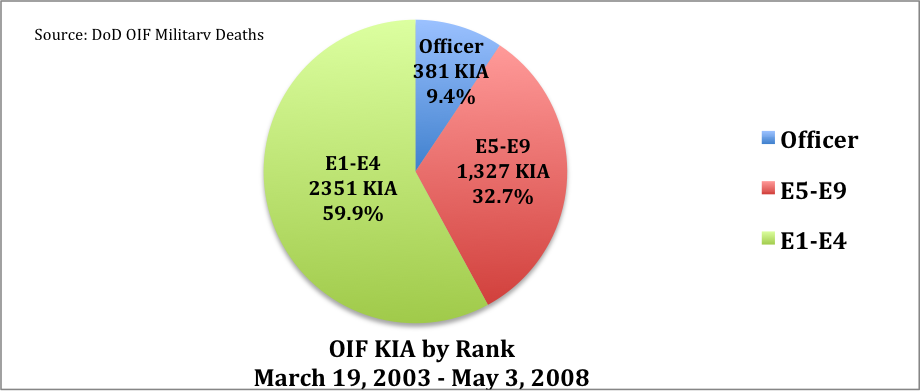
By Charles Bausman
While researching the military awards system, we came across an article published on slate.com during the early days of the Iraq War. It provided interesting commentary on who is receiving medals for valor in combat, who is not, and possible reasons for why.
The author is Owen West, a now-retired USMC Infantry Officer, who brings forth statistics on the disparity in Bronze Star awards between officers and enlisted, and how heavily weighted towards officers the system appears to be.
“As of Aug. 18 (2004), Marine officers had received nine times as many Bronze Stars as the enlisted Marines (225 times as many on a per capita adjusted basis) and 1.2 times as many earned Bronze Stars with Valor (30 times as many on a per capita basis).”
One partial explanation offered is the “burden of command” on officers; that they must put themselves in dangerous positions in order to effectively maneuver their units.
It is apparent through his article that the disparity does not sit well with the majority of enlisted troops, who seem to be far less likely to receive valor awards despite making up the majority of those actually conducting operations.
As twelve years have passed since the publication of West’s article, we wanted to see if this trend has continued, and to what extent. The Silver Star was chosen as it is awarded for combat heroism only.
Who is being awarded the third highest valor award in the United States military?
The Silver Star Example
The Silver Star does not distinguish between valor and meritorious service. It is intended to only award those who have performed heroic actions in combat.
Below is the official Silver Star criteria as outlined in DoDM 1348.33:
The Silver Star may be awarded to any individual while serving with the U.S. Armed Forces, who distinguishes himself or herself through gallantry in action under any of the following circumstances:
- While engaged in an action against an enemy of the United States.
- While engaged in military operations involving conflict with an opposing foreign force.
- While serving with friendly foreign forces engaged in an armed conflict against an opposing armed force in which the United States is not a belligerent party.
- The required gallantry, while of a lesser degree than that required for award of the Army Distinguished Service Cross, the Navy Cross, or the Air Force Cross, must nevertheless have been performed with marked distinction.
- The Silver Star medal may be awarded posthumously.
There is no rank or time in service requirement for the Silver Star. Yet the Silver Star Award numbers from Iraq and Afghanistan show a disproportionate number Silver Stars awarded to officers and senior non-commissioned officers as compared to junior enlisted troops.

As the above chart shows, the overwhelming majority (68% of total) of those awarded the Silver Star in Iraq and Afghanistan were Officers and E-6’s or above. This number included two Generals.

When compared to the overall military deaths in Iraq separated by rank (above), the Silver Star award totals may not reflect the rank of those most exposed to death from combat operations.
Those in the ranks of E-1 to E-4 represented 60% of the total soldiers killed in action.
The Department of Defense data included E-5’s, or Sergeants, into the senior enlisted totals. It would be expected that Sergeants included in the junior enlisted category would raise that percentage significantly.
It seems safe to assume that those ranks most exposed to combat would have the most opportunity for valor in combat, and it follows should have been awarded the most Silver Stars.
These numbers show that the trend identified from West’s article seems to have continued in Iraq and Afghanistan.
If junior enlisted soldiers conduct the majority of combat operations and experience the heaviest levels of casualty rates, why do they receive such a disproportionately low number of Silver Stars?
Does a Bias Exist?
The “burden of command” argument could explain some of this discrepancy. But all of it?
While the “burden of command” should not be underestimated, it does not necessarily validate the huge disparity in who the Silver Star is ultimately awarded to.
Anecdotally, we have heard of junior enlisted troops who were put up for valor awards, only them reduced or discarded entirely as the award moved up the chain for approval.
It would seem that officers and senior enlisted do not experience the same level of scrutiny.
Currently, we have no way to analyze the ranks of those who were put up for Silver Stars and other Valor awards, and who eventually received the award. If this information does exist, we can’t find it available publically.
Nowhere within the criteria for the Silver Star does it state that a leadership billet or rank must be held in order to eligible for the medal.
- Do these number point to a bias against junior enlisted soldiers being awarded medals for valor?
- Are officers and senior enlisted nominated for the Silver Star more easily approved?
- Is the burden of command a just rationale for this disparity?
- What has been your experience?
Questions, Comments, Feedback? Please email coach@mtntactical.com
You Might Also Like More Officers Less Enlisted. The Changing Force Structure of the US Military
